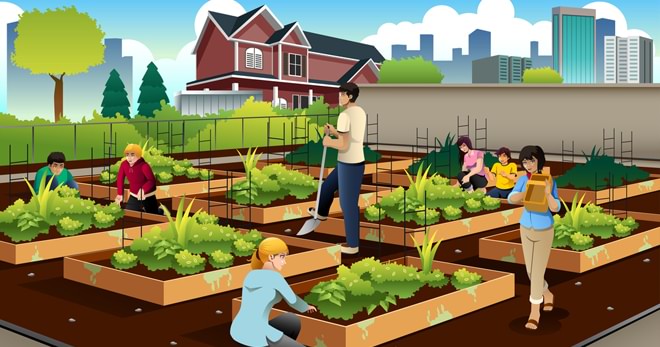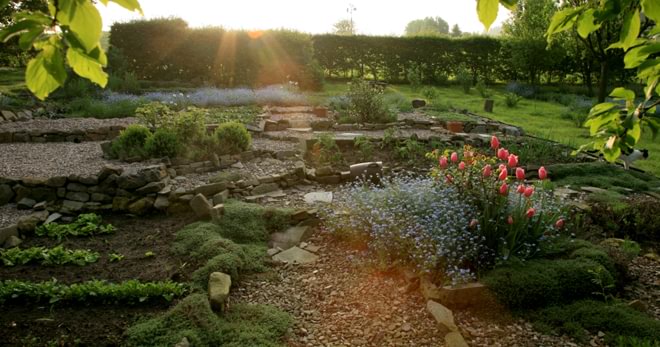Permaculture is becoming an increasingly popular buzzword to farmers and gardeners. On the suburban micro-farm, you need strategies that help reduce costs and make efficient use of your limited time.
In conventional agriculture, time-saving solutions are presented in the form of synthetic fertilizers and pesticides, but often these time-saving techniques come at the expense of the local environment.
With permaculture you can rest easy that strategies – when used appropriately – will not only save time, but also enhance the local environment.
Permaculture is basically a toolbox filled with strategies (tools) that help to create a productive and low-maintenance landscape, while improving biodiversity and regenerating soil fertility.
The tools in the permaculture toolbox aren’t all considered “permaculture” strategies, but they align with permaculture goals.
For example, permaculturists didn’t create organic gardening methods, but organic gardening is a tool used in permaculture systems because it meets the requirement to nurture the ecosystem.
Modern industrial farming would have you believe that the only way to get a worthy yield in an efficient manner is to use chemical controls at the expense of biodiversity and soil health.
Meanwhile, permaculturists and other environmental advocates are demonstrating that when you actively seek ways to regenerate fertility and biodiversity, you can increase the productivity of land and the longevity of the soil.
Indeed, as you invite nature onto your micro-farm, you may be able to reduce maintenance time, too.
Life Hacks for Micro Farmers
This farming thing is a commitment. Many of us genuinely want to have our own micro-farm and to supply our family with fresh, nutritious food. The only problem is that real-life stuff always seems to get in the way.
Do you know someone who seems to do it all? The SuperDad, or SuperMom who works full time, coaches little league, bakes cookies to welcome the new neighbors, and still manages to look good? Perhaps it is a little deceiving, for no one can truly do it all. Something eventually gets missed or left undone.
However, I also believe that those who reach seemingly impossible goals in these crazy, modern times are those who have discovered life hacks that streamline their journey to success and accomplishment.
Life hacks do four things:
- They help focus your attention on what you really want.
- They improve your chances of establishing a routine to achieve success.
- They reduce the amount of brainpower needed to accomplish a goal.
- They improve efficiency so that the time required to accomplish a goal is reduced.
In short, life hacks emphasize success over stress. They also leave little room for excuses.
Life Hack #1: 15 Minutes a Day
I like to get outside a minimum of 15 minutes each day. Whereas some people might go for a daily walk or jog, the garden is often both my daily exercise and meditation.
A daily visit allows me to be in tune with the garden, giving me the best chance to notice pest or disease problems at their onset as well as any other subtle changes.
“The rhythm of my day begins with a cup of coffee and a little bit of weeding or dreaming.” – Betsy Canas Garmon
The more time you spend there, the more you have the opportunity to connect to your land and get to know its nooks and crannies. This is why one acre of suburbia has been shown to be more productive than one acre of farmland.
You can really get to know your small piece of land when you’re connecting to it every day, season after season.
Now, to be certain, the more time you commit to your micro-farm, the more you get out of it. But don’t let perfect be the enemy of good. It’s important to be a little Zen about this suburban micro-farming thing and only do what you can do. Just 15 minutes is a great place to start.
Are you so busy that you don’t even have 15 minutes to spare? I’ve been there! When I was working outside of the home, I had to be creative about how I squeezed an extra 15 minutes out of my day for garden time. So I came up with Life Hack #2.
Life Hack #2: Split Personality
If you work away from home each day, consider dividing the 15 minutes into two pieces (7 minutes + 8 minutes):
The 7-Minute Morning: Grab your coffee and set a timer for seven minutes in the morning for watering, weeding, or doing anything else on a monthly checklist. You may even have time to throw some seeds in a new bed!
The 8-Minute Evening: Grab your happy hour drink of choice and spend eight minutes in the evening working through the monthly checklist. You might even get to harvest something for dinner!
Life Hack #3: Weekend Micro-Farming
It’s possible that the 15 minutes-a-day plan just isn’t the ticket for you while you juggle work, kids’ schedules, etc. No problem! You’ll have to block off a chunk of time each weekend and do it all at once. An hour and 45 minutes each weekend should get you started. Bonus points for extra time!
Life Hack #4: Go Small
Plant a smaller garden, such as one 3×6 raised bed. It will take more time as a beginner to learn the ropes, so keep it manageable. When you’re confident that you can manage one small bed, add another. As Mother Teresa said, “Not all of us can do great things. But we can do small things with great love.”
Life Hack #5: Avoid Seedy Affairs
Avoid planting seeds in the garden. Directly sown seeds need extra care to ensure germination, which you might not have time for. Beans, peas, and root vegetables are examples of crops that are directly sown.
If you do sow them anyway, be prepared to find joy in whatever comes up rather than disappointment in what doesn’t.
Life Hack #6: Farm Out the Work
Instead of managing an expensive and time-consuming indoor seed-starting operation, opt to buy seedlings from your local nursery or farmers’ market instead.
Life Hack #7: Perennial Beauty
Grow perennials. Perennials such as asparagus, rhubarb, fruit trees, nut trees, berry and hazelnut bushes, strawberries, and many herbs all come back year after year without much work on your end.
When It’s Not Enough
Let’s imagine you had visions of growing all of your household’s produce, cooking homegrown meals all season long, and preserving the rest for winter eating.
You worked hard all spring to try to stick to a schedule of planning the garden, preparing the soil, and starting seeds, but somewhere along the way you fell off the wagon.
You’re realizing that this grow your own food thing takes a lot more commitment than you can really give it right now.
Above, we offered some suggestions for hacking the micro-farmer’s life on a busy schedule, but it turns out your life necessitates an even more basic set of get started recommendations.
Your top priority needs to be – first and foremost – eating fresh, chemical-free produce and keeping your busy family healthy. In that spirit, here are my top recommendations for busier-than-busy micro-farmers. They also happen to be excellent options for those of us without any yard space at all.
Join a CSA
CSA stands for Community Supported Agriculture, which is a way for consumers to buy farm-fresh food directly from a local farmer. While CSAs aren’t available in all areas of the country, the probability that a CSA is available in suburban areas is high.
You might need to do some Googling or check your local farmers’ market, but the chances are good you’ll find a farmer who offers a program.
CSAs come in all shapes and sizes. Eight years ago, when we decided we wanted to grow all of our own produce, we didn’t start by creating a garden. Rather, we started in the kitchen by joining a CSA.
CSA produce is for you
CSAs are a boon for experienced gardeners who can’t seem to find time to keep a garden. A CSA will keep your family eating healthy produce and will help you establish relationships with like-minded foodies in your local area.
Let me explain why this was the most amazing first step we could have ever taken. Through the CSA, we received more produce from the local farm during that first year of membership than we have ever seen before. We didn’t even know what half the produce items were.
(What is kale? Don’t judge!) It took most of our free time to research how to use everything, prepare the food, and preserve the excess, which is excellent training for when you finally pull in your own big harvest.
I felt relieved that I wasn’t trying to figure all that out while also figuring out the gardening side of things!
The coolest part was that the CSA we joined had a “work” component, where we worked a certain number of hours on the farm with the farmer or other CSA members as part of our payment.
It gave us a chance to learn gardening skills and meet loads of other people in our own community with the same interests.
By choosing to do only one thing (kitchen prep), we still got loads of healthy veggies in our diet without trying to fit in time to grow it all.
As we constructed more and more garden beds in our own yard (starting small and increasing the garden space over time), the lessons from the CSA – both in the kitchen and in the farm fields – were priceless.

Join a Community Garden
Community gardens – at least in the United States – have the stigma of being used only by disadvantaged urban residents.
Although this is certainly true in many areas, I fought hard during my time as founder and coordinator of my local suburban community garden to dispel this stigma. I believe community gardens can be of great benefit to all communities.
They are not only assets to landless urban folks – rich or poor – but they can also benefit those in suburban areas who are challenged by shade, deer, and other challenges in their own yards, and who feel isolated in their car-centric neighborhoods.
But let’s get to the root of why community gardens are useful for super-busy micro-farmers. The thing I love about a community garden is the fact that the amount of space is defined.
A small 3×6 or 4×8 raised bed is easy to maintain when it’s not in your backyard, and here’s why: The raised bed in my backyard is in our yard, which means every time I go to take care of it I see all the other landscaping that needs maintained, that I don’t have time for.
I feel overwhelmed, and it makes me want to abandon all of it.
The community garden doesn’t feel like work, however. It’s like a mini-escape from the craziness of life! Visit your plot an hour a week, and while you’re there, you might have company from fellow gardeners.
It’s so much fun to pull weeds and shoot the breeze at the same time, with the unkempt backyard out of sight, out of mind.
For this option to be really successful, pick the same hour every week and write it on your calendar so that it’s a weekly, non-negotiable hour to yourself.
“It takes a while to grasp that a garden isn’t a testing ground for character and to stop asking, what did I do wrong? Maybe nothing.” – Eleanor Perenyi, Green Thoughts, 1981
I hadn’t realized how much I enjoyed the social aspect of gardening until I started a community garden. Gardeners at my community garden occasionally celebrate our bond with Wine Down Wednesday – a new meaning to happy hour gardening!
The camaraderie truly does make the work seem so much lighter and go so much faster, and it’s a great way to meet like-minded friends.
Whether you join a CSA or a community garden, know that there are always options for you to continue to work toward your goal of providing your family with fresh, healthy produce while learning productive skills at the same time.
As once-fertile farmland is transformed into housing developments at an ever-faster rate, it is essential that we learn efficient ways of growing food that protect the dwindling rural and wild lands that remain.
Saving them from the grip of industrial farming and its ecosystem-stripping practices is essential.
Though we have long depended on faraway lands to supply our produce, many of us now aim to grow some of our own healthy produce right where we live, using the suburbs’ most valuable asset: the under-utilized lawn.
The compact suburban micro-farm may look different from the traditional farm. It can either conform to the existing landscape or make a bold statement depending on the needs and desires of the micro-farming homeowner.
No matter your farming style, one thing is for sure: The suburban micro-farm has been shown to be more productive than farmland, so it is neither a waste of time nor space.
Modern life is busy and our yards may not be perfect farming sites. Still, it isn’t necessary to have a lot of time or flat, sunny space to be a successful micro-farmer.
All we need is a plan and a willingness to seek out micro-farming practices that match our schedule and improve efficiency. Producing chemical-free food in lieu of resource-intensive lawn may deliver cost savings both at the grocery store and at the pharmacy.
As the number of professional farmers declines, our micro-farming skills and productivity can contribute to overall food security.
We now realize that a productive micro-farm doesn’t have to come at the expense of our local ecosystem. Rather, with intentional action, biodiversity and soil fertility can skyrocket.
Strong, ecologically friendly gardens will be better able to respond to drought, flood, chemical invasions, and pests.
This won’t happen overnight, however. Creating an interconnected ecosystem will take time as well as a certain amount of trial and error, as it is a more complex affair than simply building a garden. Patience will be required as we balance modern life with building a resilient, productive micro-farm.
It will take work, but we will certainly be rewarded. I am more convinced than ever that a committed group of micro-farming pioneers can positively affect the health of both our inhabited and wild lands.
How Much Is It Worth to You to Literally Have an Unlimited Food Supply For Your Family?
Experts Are In Shock After a Crazy Guy Discovers An Automated Micro-Farm… He figured out how to easily create an automated supply of the freshest, high-quality organic foods for pennies on the dollar. It’s a Proven, step-by-step guide showing you EXACTLY how to create your own “Miracle Farm”, and how to survive any tough disaster or crisis situation.
DOWNLOAD THE BACKYARD MIRACLE FARM
After 13 years of dedicated research, there is an invention… a “food stockpile” that they can NEVER steal from you… and that will keep you and your family well fed in a crisis.
Best of luck and happy eating!
 Expert eBooks Courses | Online-eBook-Download.com Latest digital books and courses, Tips & Tricks, How-to guides, free ebooks, software discounts, coupons & much MORE… Instant Download
Expert eBooks Courses | Online-eBook-Download.com Latest digital books and courses, Tips & Tricks, How-to guides, free ebooks, software discounts, coupons & much MORE… Instant Download



